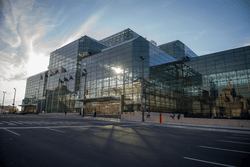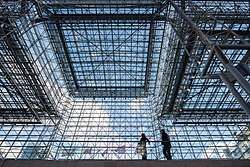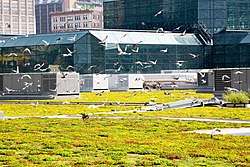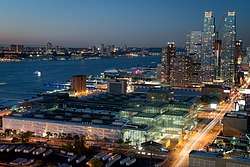Javits Center
| Jacob K. Javits Convention Center | |
|---|---|
 36th Street entrance | |
| Address | 655 West 34th Street |
| Location | Manhattan, New York 10014 |
| Coordinates | 40°45′26.64″N 74°0′9.12″W / 40.7574000°N 74.0025333°WCoordinates: 40°45′26.64″N 74°0′9.12″W / 40.7574000°N 74.0025333°W |
| Operator | New York City Convention Center Operating Corporation |
| Built | June 18, 1979 to April 2, 1986 |
| Opened | April 3, 1986 |
| Renovated | 2006-13 |
| Expanded | 2013 |
Former names | New York Convention and Exhibition Center |
| Enclosed space | |
| • Total space | 1,800,000 sq ft (170,000 m2) |
| • Exhibit hall floor | 840,000 sq ft (78,000 m2) |
| • Breakout/meeting | 103,204 sq ft (9,588.0 m2) |
| Parking | Pay parking nearby |
| Public transit access |
New York City Subway: New York City Bus: M12, M34 SBS |
| Website | |
|
www | |
The Jacob K. Javits Convention Center, commonly known as the Javits Center, is a large convention center located on Eleventh Avenue, between 34th and 40th streets, in Hell's Kitchen, Manhattan, New York City. It was designed by architect James Ingo Freed of Pei Cobb Freed & Partners. The controversial and revolutionary space frame structure was begun in 1980, finished in 1986, and named for United States Senator Jacob Javits, who died that year.[1][2] The Center is operated and maintained by the New York City Convention Center Operating Corporation. The convention center has a total area space of 1,800,000 square feet (170,000 m2)[3] and has 840,000 square feet (78,000 m2) of total exhibit space.[4]
When the Center opened, it replaced the New York Coliseum as the city's major convention facility, making way for the demolition of the Coliseum and future construction of the Time Warner Center at Columbus Circle. Today, it hosts events such as the New York International Auto Show and the New York Comic Con. It is billed as one of the busiest convention centers in the United States,[5] but it is only the twelfth-largest.[6]
Planning

Planning and constructing a convention center on Manhattan's west side has had a long and controversial history;[7] proposals for a convention center to replace the New York Coliseum date to 1962, only six years after the Coliseum was completed. A new convention center over the river between 38th and 42nd Streets was included in the City's 1962 plan for the West Side waterfront.[8] Several other sites were subsequently studied, including the New York Central rail yard between Tenth and Eleventh Avenues (now known as the Eastern Rail Yard site at the Hudson Yards) and the west 50s between Eighth and Ninth avenues.[9]
Eventually the Lindsay administration included a new convention center between 10th and 11th avenues in the west 40s along with an extensive redevelopment of the West Side in their 1969–70 Plan for New York City.[10][11] Opposition to the massive residential displacement that this development project would have caused,[12] and the failure of the City to complete any replacement housing, led the State Legislature to kill the convention center proposal in 1970. The City then moved the convention center site to the Hudson River, in place of Piers 84 and 86,[13] despite the high cost of foundations and the lack of space for future expansion. That 44th Street convention center, designed by Gordon Bunshaft of Skidmore, Owings & Merrill, was approved by the Board of Estimate in 1973 despite renewed opposition from the local community. In exchange, the community received a special zoning district that offered some protection from development.[14]
However the 44th Street convention center was never built because of the City's near bankruptcy in 1975, which led instead to a search by the City and State for a less expensive site with some opportunity for expansion. Three sites were proposed — the Penn Central rail yard between 11th and 12th Avenues north of 34th Street; Battery Park City; and in the west 40s near Times Square, somewhere between 6th and 7th Avenues or 7th and 8th Avenues. The Battery Park City site was rejected because it was considered to be too far from midtown hotels. The Times Square plan, by the Regional Plan Association, was not seriously considered by the City.[15][16]
The rail yard site was originally proposed by the local community to avoid direct residential displacement that would be caused by office and residential development associated with the convention center.[17] As an alternative to forestall the negative impacts of both, Daniel Gutman, an environmental planner working with the Clinton Planning Council, proposed that the convention center and all major development be located south of 42nd Street.[18] Their proposed convention center site — between Eleventh and Twelfth avenues from 34th to 39th streets — was later promoted by Donald Trump, who had obtained an option on the rail yard from the bankrupt Penn Central in 1975.[19] The City and State eventually chose the rail yard site.[20] Although Trump's offer to build the Convention Center was rejected, he was paid a broker's commission by Penn Central.[21] The proposal for major office and residential development south of 42nd Street was realized 30 years later in the Hudson Yards Redevelopment Project.
Construction

In March 1979, the New York State Legislature approved a plan to allocate $375 million toward the construction of the convention center near the Penn Central yard.[22] The next month, the architectural firm I. M. Pei and Partners was selected to build the New York Convention and Exhibition Center, as it was called at that time.[23] Immediately after the center's construction was announced, real estate prices in the area increased. Properties that previously had trouble selling suddenly had several potential buyers, spurring real estate speculation.[24] Designs for the center were revealed in December 1979.[25] In March 1980, a few squatters on the site were evicted so the site's structures could be demolished to make room for the New York Convention Center.[26] The ground-breaking ceremony for the center was held on June 18 of that year.[27] In October 1980, the MTA issued $100 million in bonds to pay for the center's construction.[28]
The New York Convention Center Development Corporation (CCDC), which was building the Convention Center, proposed building a promenade with restaurants and shops on the building's west side, facing the Hudson River shore. It would also be open year-round, as opposed to other convention centers. At the time, the presence of the Convention Center was supposed to garner $82 million in annual city and state taxes, and the events at the center would allow the city to net $832 million annually. However, a report commissioned by the CCDC found that the center's benefits to the surrounding neighborhood would be reduced due to a lack of public transit and the predominantly industrial zoning of the area.[29] Jerry Lowery was hired to find conventions to host at the New York Convention Center. By late 1981, he had booked 171 conventions for the Convention Center between mid-1984 and late 1986.[30]
The problems with the center's construction started in 1982, when it was revealed that there were difficulties in manufacturing the custom parts for the Convention Center's structure.[31] In March 1983, officials stated that the Convention Center was facing cost overruns of at least $16.8 million.[32] The next month, officials announced that the cost overruns had risen to between $25 million and $50 million, and that the center's opening had been postponed to at least 1985. In order to reduce the delay, workers were ordered to speed up construction.[33] Lowery described the delay as "disastrous" for the city, since the delays left the city vulnerable to lawsuits from the hosts of the 141 conventions that were scheduled to be hosted at the Convention Center through the end of 1985.[34]
By April 1984, the opening date had been delayed further to mid-1986. At the time, Governor Mario Cuomo stated that the center would have a new name by the time it opened. He said, "It should be reasonably utterable and easy to write. It should be a name that's going to identify it with New York as much as possible."[35] In December 1984, at Cuomo's suggestion, the CCDC officially renamed the New York Convention Center to honor former Senator Jacob K. Javits.[36] The Javits Center was topped out on December 19, 1984.[31]
The center was opened on April 3, 1986.[37][3][38] The opening of the Javits Center was accompanied by a five-minute ribbon-cutting ceremony. The first exhibitions to be hosted at the Javits Center were the International Fur Fair and an Art Expo of "emerging younger artists".[39] A week later, a formal ribbon-cutting was held, with Governor Cuomo, Mayor Ed Koch, and Javits's widow Marian Javits in attendance.[40]
Major components of center

- 410,000-square-foot (38,000 m2) Upper Exhibition Hall
- 250,000-square-foot (23,000 m2) Lower Exhibition Hall
- 100,000-square-foot (9,300 m2) Special Events Hall (seating capacity 3,800), 102 meeting rooms
- 63,000-square-foot (5,900 m2) cafeteria/restaurant/lounge
- 75,000-square-foot (7,000 m2) concourse (1,000 by 90 by 75 feet (305 m × 27 m × 23 m))
- 65,000-square-foot (6,000 m2) Crystal Palace (270 by 270 by 180 feet (82 m × 82 m × 55 m))
- 60,000-square-foot (5,600 m2) Galleria (360 by 90 by 90 feet (110 m × 27 m × 27 m))
- 23,400-square-foot (2,170 m2) River Pavilion (270 by 90 by 135 feet (82 m × 27 m × 41 m))
- 50 loading docks on two levels
- 1.1-acre (0.45 ha) public plaza with water walls and pedestrian link under 11th Avenue
- 60,000 square feet (5,600 m2) of surface parking for 140 cars[41]
Mafia charges
In 1995 the Independent Review Board charged that jobs at the Center had come under Mafia control. A New York Times article stated:[42]
From the day the center opened in 1986 … Robert Rabbitt Sr. and his son Michael gave the work mainly to people with mob connections, to relatives and friends of organized-crime figures and to relatives and friends of union officers, the panel said.
The jobs at the center were reserved for members of Local 807 of the International Brotherhood of Teamsters, who were paid up to $350 a day for working on a Sunday. Other local members who work outside the center are usually paid less than $100 a day, the panel said.
The panel, the Independent Review Board, which investigates corruption in the union, reported that the Rabbitts also tried to engineer a deal that would let Robert Rabbitt control the jobs after serving a prison sentence, and would give his son $236,000 as severance pay from companies that do business at the center.[42]
Expansions


On October 16, 2006, a groundbreaking ceremony was held to mark the symbolic start of a $1.7 billion expansion project. The project, which would have expanded the center's size by 45 percent, was scheduled for completion by 2010.[43] Architect Richard Rogers led the design team, and Leslie E. Robertson Associates were the structural engineers. However, the physical constraints on the project site imposed by the Bloomberg administration complicated the design and caused the cost to soar to $5 billion. To address the site constraint, an alternative plan produced in 2007 by Meta Brunzema, an architect, and Daniel Gutman, an environmental planner, for the Hell's Kitchen Neighborhood Association would have expanded the Javits Center south over the Western Rail Yard, the site of the defeated West Side Stadium. Other features of the HKNA plan included an rooftop park, office and residential towers at the corners of the new exhibition hall, and conversion of Pier 76 to public use.[44] In the end, the Mayor ignored the HKNA plan, cancelled the Javits expansion, and proposed to rezone the Western Rail Yard site for commercial and residential development as part of the Hudson Yards.
In April 2008, Governor David Paterson decided to renovate the existing Javits building with a severely revised budget of $465 million.[45] The renovation, started in 2010, was led by design team FXFOWLE Epstein, whose redesign of the Javits Center's interior focused on upgrading organization and efficiency, as well as occupant comfort. The more transparent curtain wall, less opaque skylight systems, and light gray paint on the space frame have dramatically transformed the voluminous public spaces. New mechanical systems have improved the indoor air quality, reduced ambient noise, and significantly saved on energy consumption. The diamond-patterned Tuscan red terrazzo of the original floor has been replaced with soft tones of gray terrazzo. A new high-performance curtain wall has simplified and lightened the aesthetics of the original façade by changing the façade's module from 5 by 5 feet (1.5 m × 1.5 m) to 5 by 10 feet (1.5 m × 3.0 m). This allowed for the introduction of more transparent glass with minimal structurally glazed mullions. Solid stainless steel panels replaced the opaque portions of glass to better express the building's functionality.[46] The roof of the new expansion was also made "green" by the presence of a garden in the new wing's roof.[47] The renovation was completed in November 2013.[5][48][49] The expansion was meant to retain old tenants coming back annually, such as the New York Boat Show.[6]
In January 2012, Governor Andrew Cuomo announced plans to construct a new convention center on the site of Aqueduct Racetrack in Queens and redevelop the Javits Center site with a mix of commercial space and apartments, similar to Battery Park City.[50] However, Cuomo's plan was quickly scuttled due to disagreements over space in the Aqueduct Racetrack area. More Javits Center renovations are being eyed, with $15 million already going toward a new telephone system and improved Wi-Fi network in the building, as well as a truck idling area to the west and south being proposed for further expansion.[6]
The newly expanded Javits Center is served by the New York City Subway 7 and <7> trains at the 34th Street–Hudson Yards station, which was built as part of the 7 Subway Extension in anticipation for the adjoining Hudson Yards Redevelopment Project,[51] since September 13, 2015.[52] The expanded Javits Center, along with the completed High Line, the new Hudson Park and Boulevard, and the subway extension, are facilitating the development of Hudson Yards.[53]
In January 2014 it was revealed that the new roof was still leaking after the expansion.[54]
In January 2016, Governor Cuomo announced that the Javits Center would be expanded again (to 3,000,000 feet (910,000 m)), at a cost of US$1.5 billion. Javits North, a "semi-permanent structure" located at the 40th Street end of the Javits Center, would be demolished and replaced by a new glass building with "meeting rooms, new exhibition halls and outdoor space." The further expansion of the Javits Center was proposed in order to help New York State's economy.[55] The consortium chosen is made up of project manager Lend Lease Group and Turner Construction Company, a subsidiary of Hochtief which is controlled by Spanish company ACS Group.[56][57][58]
See also
References
- ↑ Purnick, Joyce (June 18, 1980). "Carey, Koch Join Forces To Celebrate New Center". The New York Times. Retrieved January 6, 2012.
- ↑ Gottlieb, Martin (April 4, 1986). "Javits Center Bustles on Opening Day". The New York Times. Retrieved January 6, 2012.
- 1 2 "Javits Convention Center". GreatBuildings. Retrieved September 10, 2014.
- ↑ The Northeast - Jacob K. Javits Convention Center Archived October 19, 2013, at the Wayback Machine.
- 1 2 "New York's Javits Center Completes 110,000 Square Foot Expansion, $465 Million Renovation - TSNN Trade Show News". Retrieved September 10, 2014.
- 1 2 3 "Javits Center expansion revisited - Crain's New York Business". Crain's New York Business. Retrieved September 10, 2014.
- ↑ "Convention site called a danger; West Side Group Will Sue on Ground of Pollution Environmental Study". The New York Times (03624331). August 22, 1973. p. 56. Retrieved January 4, 2012.
- ↑ George Horne, "670-Million, 40-Year Waterfront Plan To Alter West Side Is Urged by Mayor; Convention Center, Docks and Housing Would Be Built," New York Times, April 26, 1963.
- ↑ Seth S. King, "CONVENTION HALL WEIGHED BY CITY; Two Studies of Needs and Facilities Are Ordered," New York Times, February 10, 1967.
- ↑ Burks, Edward C. (March 25, 1970). "New Exhibit Hall Planned Here". The New York Times.
- ↑ Stern, Michael (December 8, 1970). "6TH AND LAST PART OF MASTER PLAN ON CITY RELEASED; Volume on Manhattan Urges Building of Offices Along 48th St. Transit Line WESTWARD PATTERN SET Condemnation of Big Tracts Intended to Insure Public Use of Some of Area". The New York Times. Retrieved September 20, 2015.
- ↑ Blumenthal, Ralph (March 7, 1972). "ELLIOTT ASSAILED AT PLAN HEARING; Clinton-Chelsea Residents Denounce Proposals". The New York Times.
- ↑ Burks, Edward C. (February 24, 1971). "City Planning Convention Center". The New York Times.
- ↑ Fowler, Glenn (November 22, 1974). "CITY IS LIMITING CLINTON BUILDING; Board of Estimate Enacts Special Zoning Controls on Runaway Development". The New York Times. Retrieved September 20, 2015.
- ↑ Oser, Alan S. (June 9, 1976). "About Real Estate; Some Urge Convention Center in Midtown". The New York Times.
- ↑ Glenn Fowler, "Panel Recommends Convention Center Near 34th on River," New York Times, November 23, 1977.
- ↑ Stern, Michael (December 8, 1970). "6TH AND LAST PART OF MASTER PLAN ON CITY RELEASED; Volume on Manhattan Urges Building of Offices Along 48th St. Transit Line WESTWARD PATTERN SET Condemnation of Big Tracts Intended to Insure Public Use of Some of Area". The New York Times. Retrieved September 20, 2015.
- ↑ Darnton, John (February 14, 1973). "Convention Center Model Unveiled Here With Pride; A Dissenting View". The New York Times. Retrieved September 20, 2015.
- ↑ "Developer Proposes a Convention Center in Midtown". The New York Times. December 18, 1975. Retrieved September 20, 2015.
- ↑ Kaiser, Charles (April 29, 1978). "Convention Site At West 34th St. Chosen by Koch; He and Carey Outline Plans for Center". The New York Times. Retrieved September 20, 2015.
- ↑ Marilyn Bender, "The Empire and Ego of Donald Trump," New York Times, August 7, 1983.
- ↑ Goldman, Aril (March 30, 1979). "Legislature Votes Convention Center for New York City". The New York Times. ISSN 0362-4331. Retrieved February 14, 2018.
- ↑ McFadden, Robert D. (April 22, 1979). "I. M. Pei Will Design Convention Center". The New York Times. ISSN 0362-4331. Retrieved February 14, 2018.
- ↑ Barron, James (June 3, 1979). "In Convention Center Area, Hopeful Sellers Lift Prices". The New York Times. ISSN 0362-4331. Retrieved February 14, 2018.
- ↑ "ARCHITECTURE VIEW; Redeveloping New York". The New York Times. December 23, 1979. ISSN 0362-4331. Retrieved February 14, 2018.
- ↑ "ARCHITECTURE VIEW; Redeveloping New York" (PDF). The New York Times. December 23, 1979. ISSN 0362-4331. Retrieved February 14, 2018.
- ↑ "Carey, Koch Join Forces To Celebrate New Center; Carey, Mayor At Ceremonies Of New Center" (PDF). The New York Times. June 18, 1980. ISSN 0362-4331. Retrieved February 14, 2018.
- ↑ "Bonding to Build Convention Hall Gains Approval; M.T.A. Officials Override Objection on Guarantee Legislature Created Corporation 'An Open Process' M.T.A Approves a Bond Issue for Convention Hall" (PDF). The New York Times. October 18, 1980. ISSN 0362-4331. Retrieved February 14, 2018.
- ↑ Fleetwood, Blake (January 7, 1981). "New Convention Center Will House Shops, Too". The New York Times. ISSN 0362-4331. Retrieved February 18, 2018.
- ↑ Dickenson, Ernest (November 29, 1981). "In Selling Conventions, It's Better to Be No.1". The New York Times. ISSN 0362-4331. Retrieved February 18, 2018.
- 1 2 Gottlieb, Martin (December 20, 1984). "Javits Center: 2 Views; Convention Project to Bring Benefits, but Its Unmet Goals Leave Questions". The New York Times. ISSN 0362-4331. Retrieved February 18, 2018.
- ↑ Raab, Selwyn (March 7, 1983). "Convention Site Faces Overruns of $16 Million". The New York Times. ISSN 0362-4331. Retrieved February 18, 2018.
- ↑ Gottlieb, Martin (April 5, 1983). "Officials Hoping for Faster Work on Meeting Hall". The New York Times. ISSN 0362-4331. Retrieved February 18, 2018.
- ↑ Oreskes, Michael (March 31, 1983). "Booker for City Convention Center Sees Delays as Economic Disaster". The New York Times. ISSN 0362-4331. Retrieved February 18, 2018.
- ↑ Gottlieb, Martin (April 25, 1984). "Convention Site: New Name?". The New York Times. ISSN 0362-4331. Retrieved February 18, 2018.
- ↑ Gottlieb, Martin (December 13, 1984). "Search for a Name New York's New Convention Center Ends in 'javits'". The New York Times. ISSN 0362-4331. Retrieved February 18, 2018.
- ↑ Gottlieb, Martin (April 3, 1986). "Javits Hall Is Poised to Exhibit". The New York Times. ISSN 0362-4331. Retrieved February 14, 2018.
- ↑ Pei Cobb Freed & Partners—Jacob K. Javits Convention Center and Plaza
- ↑ Gottlieb, Martin (April 4, 1986). "Javits Center Bustles on Opening Day". The New York Times. ISSN 0362-4331. Retrieved February 14, 2018.
- ↑ Heller Anderson, Susan; Bird, David (April 10, 1986). "NEW YORK DAY BY DAY; Ribbons at Javits Center". The New York Times. ISSN 0362-4331. Retrieved February 18, 2018.
- ↑ Jacob K. Javits Convention Center and Plaza - Pei Cobb Freed & Partners Architects LLP.
- 1 2 Raab, Selwyn (May 4, 1995). "Panel Says Mob's Friends Got Teamster Jobs at Javits Center". The New York Times. Retrieved January 4, 2012.
- ↑ "Final Scoping Document No. 7 Subway Extension -- Hudson Yards Rezoning and Development Program CEQR No. 03DCP031M Draft Generic Environmental Impact Statement (DGEIS)" (PDF). nyc.gov. New York City Department of City Planning. 2003. Archived from the original (PDF) on March 4, 2016. Retrieved November 1, 2015.
- ↑ HKNA plan
- ↑ Brown, Elliot (April 2, 2008). "Javits Renovation Plan Doesn't Go the Way of Client 9". The New York Observer. Archived from the original on May 23, 2011. Retrieved January 6, 2012.
- ↑ "Jacob K. Javits Convention Center Renovation and Expansion". ENR New York. June 1, 2010. Retrieved September 10, 2014.
- ↑ "NYREJ - Project of the Month: FXFOWLE, Epstein and Tishman complete renovation/ expansion of $465 million Jacob K. Javits Convention Center". Retrieved September 10, 2014.
- ↑ "Javits Convention Center Celebrates Renovation, Expansion, New Green Roof - Green Lodging News". Green Lodging News. Retrieved September 10, 2014.
- ↑ "First look: Jacob K. Javits Convention Center renovation and expansion [slideshow]". Retrieved September 10, 2014.
- ↑ Lovett, Kenneth (January 4, 2012). "Cuomo Administration Inks Agreement with Developer to Build Convention Center at Aqueduct Racetrack". Daily News. New York. Retrieved January 5, 2012.
- ↑ "Alan Steel Interview". The New York Times. May 6, 2014. Retrieved September 10, 2014.
- ↑ Tangel, Andrew (August 28, 2015). "At Last: New Station for 7 Train Set to Open". WSJ. Retrieved September 10, 2015.
- ↑ Daniel Geiger (October 6, 2013). "Hudson Yards' lucky No. 7". Crains New York Business. Retrieved August 27, 2014.
- ↑ "Javits Center roof continues to leak despite $465M fix - New York Post". New York Post. January 26, 2014. Retrieved September 10, 2014.
- ↑ Bagli, Charles V. (January 7, 2016). "Cuomo Announces $1 Billion Expansion for Javits Center". The New York Times. Retrieved February 7, 2016.
- ↑ "ACS ampliará por 1.400 millones el mayor centro de convenciones en Nueva York". Expansión (in Spanish). EFE. February 8, 2017. Retrieved February 8, 2017.
- ↑ Rosenberg, Zoe (January 31, 2017). "Javits Center's $1.5B expansion now has a design team". Curbed NY. Retrieved February 8, 2017.
- ↑ "State taps Lendlease, Turner Construction for Javits expansion". The Real Deal. January 31, 2017. Retrieved February 8, 2017.
External links

- Official website

| Preceded by The Theatre at Madison Square Garden |
Venues of the NFL Draft 2005 |
Succeeded by Radio City Music Hall |